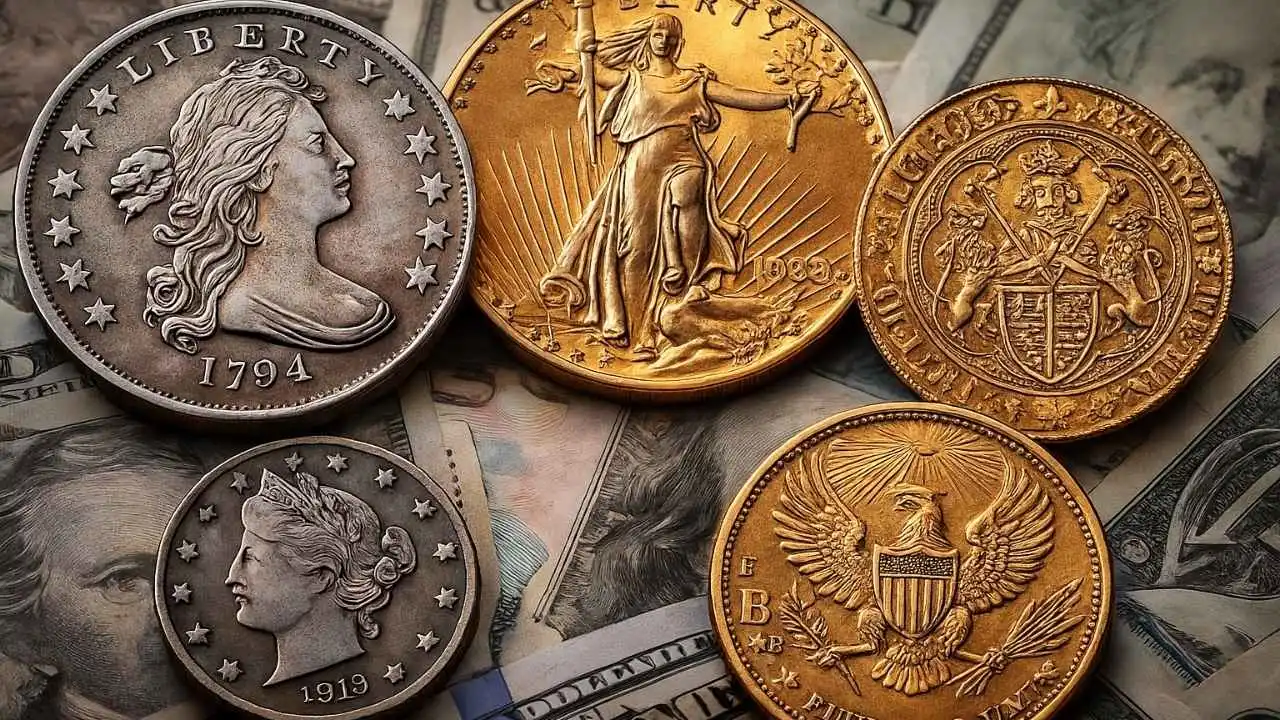What if a small coin in your pocket was worth millions of dollars? It might sound unbelievable, but several rare coins still in circulation have fetched staggering prices at auctions — totaling over $96 million combined. Hidden in old wallets, inherited collections, or even loose change, these coins are more than currency; they’re pieces of history that could make you rich overnight.
In this article, we’ll look at five of the rarest and most valuable coins ever discovered, why they’re worth so much, and how you might identify one if luck strikes your way.
1. 1794 Flowing Hair Silver Dollar – $12 Million
The 1794 Flowing Hair Silver Dollar is believed to be the first silver dollar ever minted in the United States, marking the beginning of American coinage. Designed by Robert Scot, it features Lady Liberty on the obverse with flowing hair, symbolizing freedom and new beginnings.
- Composition: 90% silver, 10% copper
- Mintage: Around 1,758
- Surviving examples: Approximately 140 known
Because of its age, artistic design, and historical importance, this coin is considered the “Holy Grail” of American numismatics. In 2013, a pristine specimen sold for $12 million, making it one of the highest-selling coins in the world.
Collectors cherish it not only for its rarity but for what it represents — the very start of America’s identity as a nation with its own currency.
2. 1933 Saint-Gaudens Double Eagle – $18.9 Million
The 1933 Saint-Gaudens Double Eagle has one of the most dramatic stories in coin history. Although 445,000 of these $20 gold coins were struck by the U.S. Mint, they were never released into circulation because President Franklin D. Roosevelt abandoned the gold standard that year.
- Designer: Augustus Saint-Gaudens
- Metal: 90% gold, 10% copper
- Face value: $20
- Auction record: $18.9 million (2021, Sotheby’s)
Most of these coins were melted down, but a few secretly escaped the Mint — and their discovery has led to multiple legal battles between collectors and the government. One example sold for nearly $19 million, setting a world record.
This coin represents a time when the U.S. was shifting its economic foundation — and it remains one of the most iconic and desirable coins among collectors.
3. 1343 Edward III Florin – $6.8 Million
Traveling back to medieval England, the 1343 Edward III Florin, also known as the “Double Leopard,” is a gold coin that’s over 680 years old — and among the rarest on Earth.
- Country: England
- Material: Gold
- Known examples: Only 3
The Florin was minted under the rule of King Edward III for international trade but was quickly withdrawn because it didn’t meet the gold standard for European commerce. Today, only three examples are known to exist.
Its exquisite medieval artwork and deep historical roots make it a treasure among historians and collectors alike. One sold for $6.8 million, and experts believe that if another were to appear, it could exceed $10 million due to its rarity.
4. 1913 Liberty Head Nickel – $5 Million
The 1913 Liberty Head Nickel is one of the most mysterious coins ever made. Only five are known to exist — and none were officially authorized by the U.S. Mint.
- Mintage: 5
- Composition: 75% copper, 25% nickel
- Auction record: $5 million (private sale)
These coins were likely struck in secret at the Philadelphia Mint before the official release of the Buffalo Nickel in 1913. Each of the five Liberty Head Nickels has a colorful history involving private ownership, theft, and rediscovery.
Their allure lies in their mystery — ordinary in appearance yet worth millions. One sold privately for $5 million, and the others are held in museums or private collections.
5. 1787 Brasher Doubloon – $53 Million
The Brasher Doubloon is perhaps the most valuable coin in American history. It was privately minted in New York City in 1787 by Ephraim Brasher, a goldsmith and silversmith who was a neighbor of George Washington.
- Composition: Gold
- Design: State seal of New York and the U.S. eagle emblem
- Mintage: Only a handful
This coin predates the U.S. Mint itself, representing America’s early entrepreneurial spirit. Because of its craftsmanship, rarity, and historical value, one specimen was sold in a private transaction for a staggering $53 million, setting an all-time record.
The Brasher Doubloon embodies America’s founding legacy — rare, handcrafted, and priceless.
Why Are These Coins Worth So Much?
Rarity alone isn’t what makes these coins valuable — it’s the combination of scarcity, history, and condition. Coins with minting errors, limited releases, or unique backstories attract massive interest from collectors and investors.
Other factors that influence coin value include:
- Historical context: Tied to major national or global events
- Condition (Grade): Coins rated “MS” (Mint State) or “Proof” command the highest prices
- Metal composition: Gold and silver coins have intrinsic precious metal value
- Collector demand: The more famous the coin, the higher the competition
In short, each coin is a tangible piece of history — and collectors are willing to pay fortunes to own one.
Where Could You Find One?
You might think these coins are long gone, but rare discoveries happen every year. People have found million-dollar coins:
- In old jars and drawers
- From inherited collections
- At garage sales or flea markets
- Hidden in bank rolls or thrift store boxes
So before tossing your spare change, it’s worth a closer look — that dusty penny or old silver coin could be worth more than you think.
How to Identify a Valuable Coin?
If you think you’ve stumbled upon something special, check for:
- Minting errors (off-center strikes, double dies, wrong dates)
- Unique materials (copper vs. steel, gold vs. alloy)
- Key years like 1909, 1913, 1933, or 1943
- Mintmarks (S, D, or no mark)
- Unusual shine or detail
Never clean or polish a coin before appraisal — it can drastically reduce its value.
What to Do If You Find One?
- Handle it carefully – Use cotton gloves or hold by the edges.
- Store it safely – Use coin holders or plastic sleeves.
- Get it appraised – Contact professional grading services like PCGS or NGC.
- Research recent sales – Auction records can help estimate real value.
- Consider authentication – Many high-value coins are counterfeited, so certification is key.
Conclusion: A Hidden Fortune in Your Pocket
Coins are more than metal; they are time capsules of civilization. The five rare coins worth $96 million prove that even everyday objects can hold extraordinary value.
Whether you’re a casual collector or someone just checking change at the grocery store, always look closely. History — and perhaps a small fortune — could be sitting right in your hand.
FAQs
Why are these coins worth so much money?
Because of their extreme rarity, historical importance, and pristine condition. Collectors pay millions for the chance to own them.
Can I really find a rare coin in circulation?
Yes. While rare, valuable coins have been discovered in everyday transactions, old piggy banks, and inherited boxes.
What should I do if I think I have one?
Don’t clean it. Store it safely and get it professionally appraised.
Where can I sell rare coins?
Through auction houses, certified dealers, or coin shows. Always verify legitimacy before selling.
How can I learn more about coins?
Visit the websites of PCGS (Professional Coin Grading Service) and NGC (Numismatic Guaranty Company) for resources and authentication services.

